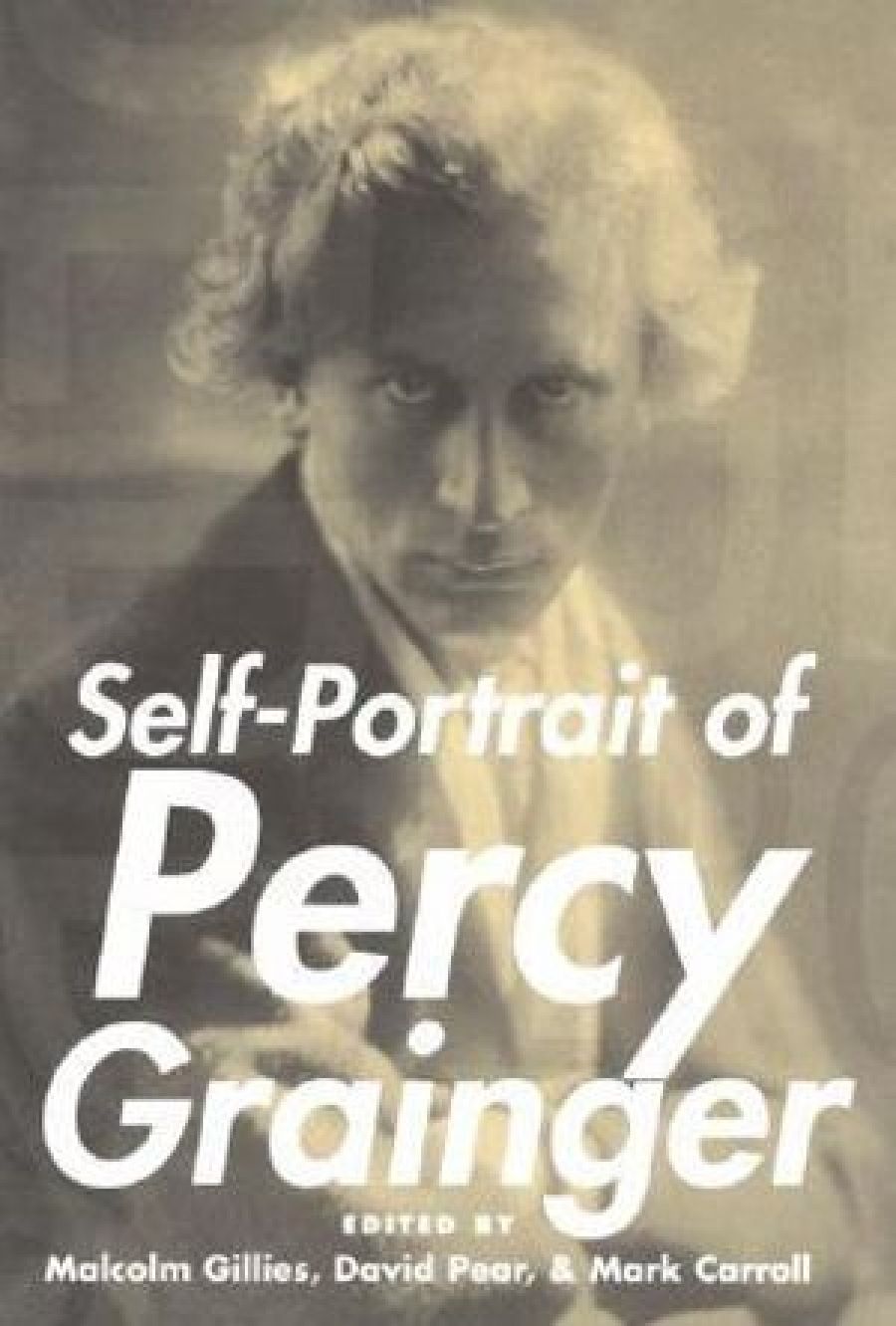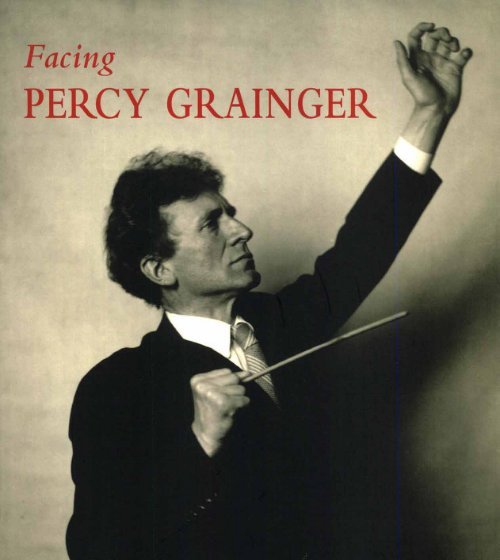
- Free Article: No
- Contents Category: Biography
- Review Article: Yes
- Online Only: No
- Custom Highlight Text:
To paraphrase Winston Churchill’s description of Russia as a riddle wrapped in a mystery inside an enigma, Percy Grainger is a minstrel wrapped in a harlequin inside a jack-in-the-box. His personality, obsessions, and general eccentricities still cause one to gasp and stretch one’s eyes even almost half a century after his own hypnotic eyes closed forever. His music, too, remains quicksilver; indefinable in its eclecticism, yet the work of a sprite who was also a genius who, magpie-like, collected music from wildly different sources to stuff into the capacious if overcrowded nest that was his mind.
- Book 1 Title: Self-Portrait of Percy Grainger
- Book 1 Biblio: OUP, $120 hb, 288 pp
- Book 1 Readings Link: booktopia.kh4ffx.net/XboZo
- Book 2 Title: Facing Percy Grainger
- Book 2 Biblio: NLA, $24.95 pb, 74 pp
- Book 2 Cover Small (400 x 600):

- Book 2 Cover (800 x 1200):

- Book 2 Cover Path (no longer required): images/ABR_Digitising_2020/March_2020/facing-percy-grainger-national-library-of-australia.jpg
Grainger’s use of language is profoundly confusing, written ‘as much to house [his] linguistic experiments and ploys as to record facts and ideas’. Thus, the originals veer between English, Danish, Swedish, Maori, German, French, Greek, and Nordic, which must have made the editors feel as if they were driving along a freeway whose ever-changing signage indicated that they were somehow passing through England, Scandinavia, continental Europe, New Zealand, and Middle Earth. The last comes courtesy of a language that was largely Grainger’s own invention. ‘Blue-eyed’ English was designed to reflect what he regarded as the purity of northern roots as against the more infectious southerly, Graeco-Roman (‘dark-eyed’) linguistic influences. It is slightly helpful in that, for at least some of the more obscure terms, he supplies an exquisitely Graingeresque device, double parentheses, containing his own translations. Try this for size:
I have always believed in the wish-for-ableness ((desirability)) of building up a mainly Anglo-Saxon-Scandinavian kind of English in which all but the most un-do-withoutable ((indispensable)) of the French-begotten, Latin-begotten & Greek-begotten words should be side-stepped ((avoided)) & in which the bulk of the put-together ((compound)) words should be wilfully & owned-up-to-ly ((admittedly)) hot-house-grown out of Nordic word-seeds.
This sprawling collage of Grainger’s writings – if they are a series of shaggy-dog stories, then let us respect his blue-eyed English roots and call them Great-Dane Tales – has been sensibly arranged into two parts whose subsections further impose a sense of order that is, more or less, chronological: The Man (Forebears, Father, Mother, Friends, Wife, Self); and The Musician (Composer, Performer, Commentator). The symmetry so lacking in the original writings has found form and substance in what Gillies calls the ‘intriguing symmetry’ of Grainger’s own life: the death of his mother, Rose, when he was thirty-nine, and the long period of adjustment, which included marriage, and postlude towards his death at the age of seventy-eight. In a way, Grainger’s life describes the same half-circle as the architecture of the Grainger Museum at the University of Melbourne.
One could be bold and suggest that Grainger loved his mother, his wife, Ella Ström, Grieg, and Delius, but was a hater on an epic scale. The Things I Dislike (1954), begins ‘Almost everything’, and lists, in no particular order, foreigners (‘except the British, the Scandinavians & the Dutch’), Haydn, Mozart, Beethoven, fame (‘including my own’), audiences, ‘all mention of my past’, most of his music teachers, teaching, parents who allow their children to become soldiers, fast automobiles, white bread, and orchestration of his works.
Which brings us to sex and, of course, flagellation. Percy liked those! In what could be termed the sealed sections of the self-portrait, Grainger lets rip, as it were, on subjects sexual. In an essay titled To Whoever Opens the Package Marked ‘Do Not Open until 10 Years after My Death’ (1956 – not opened, as requested, until 1971), he writes: ‘I attach enormous importance to flagellantism … Much of civilisation consists of turning hostility into playfulness.’ Before then, though, in earlier essays, Grainger wrote about sexual pleasure in various forms, taking the opportunity to call vital equipment by anything other than Anglo-Saxon names: ure (penis); ureroa (erect penis), whanganui (vagina); momoe (coitus); tara (clitoris).
Under all this – beneath the word-seeds, the whanganuis and the myriad of Graingerspeak generalisations – lurks a man with a genuinely musical heart, anxious to pass on his practical and theoretical enthusiasms. Percy Grainger on Ideals (mid-1920s) explores what a young pianist must do to begin a career, advice that is even more pertinent in this age of marketing:
Too often, I fear, he has his eyes fixed principally on the career and its emoluments rather than on the inner musical life he should constantly cultivate and enrich. The inner world must be paramount, must count for everything; the outer life will then take care of itself … Careers are not made in a day, in a year or even two. They take time.
Grainger’s musical colleagues, too, are encountered along the way almost as a pilgrim might find an interesting landlord or two in the more penitential towns on the way to redemption. Thomas Beecham, who offered Grainger a job, was turned down because ‘I couldn’t trust a dark-eyed man’. The English composer Balfour Gardiner, who fared better (Grainger takes particular delight in Gardiner’s sudden comment, ‘Vaughan Williams is a miserable composer’), is recalled in a succinct paragraph:
Balfour was never cleverer than when he wrote (a year or so before his death) that composers should be content with obscure successes, as the local hat shop is. The hat shop is pleased if it sells a hat & a composer should not always aim at world fame, but be thankful if his work is done in some place. The arc-light of world fame need not glare upon everything a composer does.
Alas, but inevitably, this book is festooned with many, many footnotes. They are essential and, in quite a few cases, positively welcoming and enlightening. These, in conjunction with the text, supply what is undoubtedly the closest we will ever come to a Percy Grainger autobiography – with a little bit of help from his friends.
An adjunct to Self-Portrait of Percy Grainger is Facing Percy Grainger, the catalogue to the exhibition of the same name at the National Library of Australia, which ends on October 15. Compiled by David Pear (one of the editors of Self-Portrait), this is a collection of succinct essays on Grainger’s creative and personal life, along with illustrations that match the composer’s chronology and eccentricities. The whips are there, as you would expect, but also scores, artworks, photographs and a cast of Grainger’s hands – where it all begins and ends, I suppose.


Comments powered by CComment